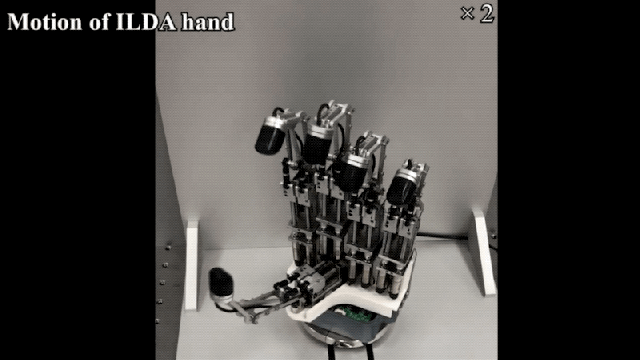Engineers in Korea have developed a highly dexterous robotic hand that’s capable of crushing beer cans or gently clutching an egg.
“Out of the 206 bones in the human body, 54 bones are in the hands, corresponding to a quarter of the total number of bones,” declares the opening paragraph of new research published today in Nature Communications. Not to mention the muscle structure that drives these bones, which is “also extremely complex,” as the paper, co-authored by Uikyum Kim from Ajou University in Korea, points out.
Indeed, the human hand is an extraordinary evolutionary accomplishment, which makes the new robotic hand, named ILDA (integrated linkage-driven dexterous anthropomorphic), all the more impressive. Its 20 joints allow for an impressive 15 degrees of freedom, and its fingertips can exert 34 Newtons, or 4 kg, of force. At a maximum length of 8.6 inches and a weight of 1 kg, the hand is both compact and lightweight. In tests, the hand successfully crushed cans, held eggs, and even used scissors to cut paper.
A cool advantage of ILDA is that it’ll be easier to combine with many existing commercial robot arms. For roboticists, this has posed a challenge because the actuators used for moving robotic hands, and also some electrical components, are often “attached in the form of a fairly large forearm,” as Kim explained in an email.
A key innovation of the new robotic hand is that all components are integrated within the hand itself. It has no external parts or modules, such as a forearm, so ILDA can be mounted easily onto pre-existing commercial robot arms.
A new linkage-driven mechanism, which Kim described as the “core technology of this research,” distinguishes it from other robotic hands. This mechanism, which has never been used before in robotics research, allows each finger to have three degrees of freedom, similar to the three-jointed fingers of humans, Kim said. “It is difficult to independently implement the movement of the medial joint [located near the knuckle] and the movement of the intermediate joint [the middle joint],” Kim explained. The new mechanism overcomes this problem, he said.
In a set of experiments, ILDA exhibited a wide range of capabilities, crushing cans, pressing buttons, using tweezers to handle tiny objects, squeezing small balls, and even using scissors to cut paper. “It is interesting that, while being a dexterous robotic hand with a high degree of freedom, it can generate a strong grip force that can lift even a heavy object weighing 18 kg [40 pounds],” said Kim.
The device could eventually be used as a prosthetic hand, but Kim says it could also be used as an industrial robot owing to its adaptable design, high performance, and low manufacturing cost. Looking ahead, Kim and his colleagues hope to imbue ILDA with tactile sensing, greater flexibility, and possibly even artificial skin.
More: Grasping Robotic Drone Can Land on a Branch Like a Freakin’ Bird.
